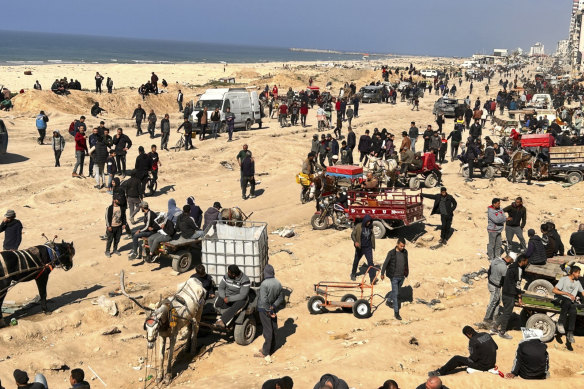This was published 1 year ago
Hungry Palestinians crowd on beaches as food is dropped from planes
By Michelle Nichols and Suleiman Al-Khalidi
Amman: Hungry Palestinians lined the shore in Gaza to receive food dropped by Jordanian, Egyptian and French planes as a humanitarian situation in the war-torn enclave looms.
Three Jordanian C-130 military transport aircraft joined four other planes from Egypt, Qatar, France and the UAE, in the biggest air drop operation so far to Gaza, the army said.

Palestinians wait for humanitarian aid on a beachfront in Gaza City.Credit: AP
The flow of aid entering Gaza from Egypt has declined dramatically in the past few weeks, but Israel has said it is not blocking aid and blames the UN and the Palestinian side for any delays.
Jordan’s King Abdullah, who participated in an air drop of aid to Gaza, said food and aid to the war-torn enclave must be doubled to avert worsening an already “catastrophic humanitarian situation”.
The monarch was quoted by state media as telling visiting USAID chief Samantha Power that the international community had to put more pressure on Israel to ease restrictions on the flow of food into the territory.
At least one quarter of Gaza’s population – 576,000 people – are one step away from famine and virtually the entire population desperately needs food resulting in some aid trucks being shot at, looted and overwhelmed by hungry people, a senior UN aid official told the Security Council, warning that widespread famine could be “almost inevitable” without action.
“Very little will be possible while hostilities continue and while there is a risk that they will spread into the overcrowded areas in the south of Gaza. We therefore reiterate our call for a ceasefire,” said Ramesh Rajasingham, coordination director of the UN Office for the Coordination of Humanitarian Affairs.
And as grim as the picture is today, he said “there is every possibility for further deterioration”.
One in six children aged under two in northern Gaza suffers from “acute malnutrition and wasting”, according to the World Food Program, and practically all the 2.3 million people in the Palestinian enclave rely on “woefully inadequate” food aid to survive, he told the 15-member Security Council.
Rajasingham said the UN and aid groups face “overwhelming obstacles just to get a bare minimum of supplies into Gaza.”
The obstacles include crossing closures, restrictions on movement and communication, onerous vetting procedures, unrest, damaged roads and unexploded ordnance, he said.
Jordan is urging its Western allies to lobby Israel to increase aid coming from the kingdom via Kerem Shalom on the border of Egypt, Israel and Gaza, beyond the existing Rafah crossing, officials say.
“His majesty stressed the need to open land crossings and expand air drops to help the people of Gaza and especially in northern Gaza,” the monarch was quoted as telling Power.
Later the king went on board a Jordanian military plane to take part in a joint operation co-ordinated with several countries’ air forces to drop tonnes of food parcels along the Gaza coast for a second day.
A palace statement said the monarch was also at the airport before the planes took off to check that humanitarian supplies were ready and preparations were completed.
The US urged its ally Israel to keep border crossings open for humanitarian aid deliveries to Gaza and to facilitate opening of more crossings, Deputy US Ambassador to the UN Robert Wood told the Security Council.
“Simply put, Israel must do more,” he said. “We continue to call on Israel to improve deconfliction procedures to ensure aid can move safely and securely.”
The World Food Program “is ready to swiftly expand and scale up our operations if there is a ceasefire agreement”, deputy executive director Carl Skau told the Security Council.
“But, in the meantime, the risk of famine is being fuelled by the inability to bring critical food supplies into Gaza in sufficient quantities, and the almost impossible operating conditions faced by our staff on the ground,” Skau said.
In the latest example of the breakdown of civil order, Skau said the grogram resumed deliveries to northern Gaza for the first time in three weeks on February 18, and hoped to send 10 trucks a day for seven days to address immediate food needs and provide some reassurance to people that sufficient food would be arriving.
But on both February 18 and 19, he said, WFP convoys faced delays at checkpoints, gunfire and other violence and the looting of food.
“At their destination, they were overwhelmed by desperately hungry people,” he said.
Skau said “the breakdown in civil order, driven by sheer desperation, is preventing the safe distribution of aid – and we have a duty to protect our staff.”
The war in Gaza began when Hamas fighters attacked Israel on October 7, killing about 1200 people and seizing 253 hostages, according to Israeli tallies. Israel’s air and ground campaign in Gaza has since killed about 30,000 Palestinians, health authorities in the Hamas-run enclave say.
Israel’s campaign in Gaza “is a collective punishment for the Palestinian civilian people”, Algeria’s UN ambassador Amar Bendjama told the Security Council. “Our silence grants a licence to kill and to starve the Palestinian population.”
Reuters, AP
Get a note directly from our foreign correspondents on what’s making headlines around the world. Sign up for the weekly What in the World newsletter here.